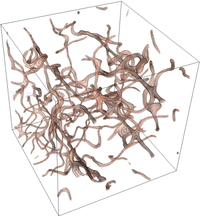Fermionic quantum turbulence: Pushing the limits of high-performance computing

Selected frame of the time evolution of vortex tangle in the strongly interacting ufg (akF → ∞) superfluid gas. For the simulation we used a periodic lattice with N3 = 1003 points. To see the full movie click here.
G. Wlazlowski, M. M. Forbes, S. R. Sarkar, A. Marek, M. Szpindler,
Fermionic quantum turbulence: Pushing the limits of high-performance computing,
PNAS Nexus 3, pgae160 (2024) [arXiv:2310.03341].
All data underlying this study are accessible via Zenodo repository, record 8355244.
We present large simulations of fermionic quantum turbulence to date and explain the computing technology needed, especially improvements in the Eigenvalue soLvers for Petaflop Applications (elpa) library that enable us to diagonalize matrices of record size. We quantify how dissipation and thermalization proceeds in fermionic quantum turbulence, and provide evidence that the temperature-dependence of quantum vortices alters the correlation between the turbulent cascades of flow energy and total vortex length. All simulation data and source codes are made available to facilitate rapid scientific progress in the field of quantum turbulence.
These data have been obtained on LUMI supercomputer, owned by the EuroHPC Joint Undertaking, hosted by CSC (Finland) and the LUMI consortium through project "Turbulent dynamics in superfluid Fermi systems", granted by Academic Computer Centre Cyfronet AGH (Poland).
